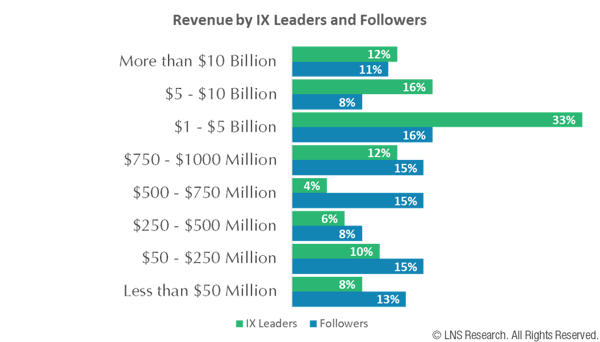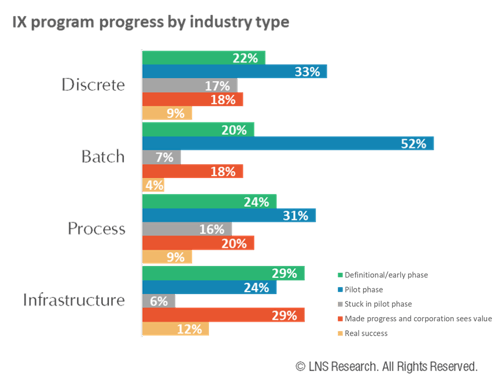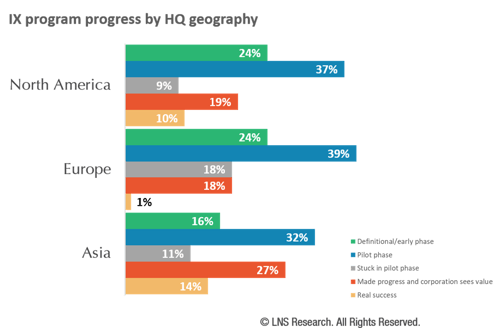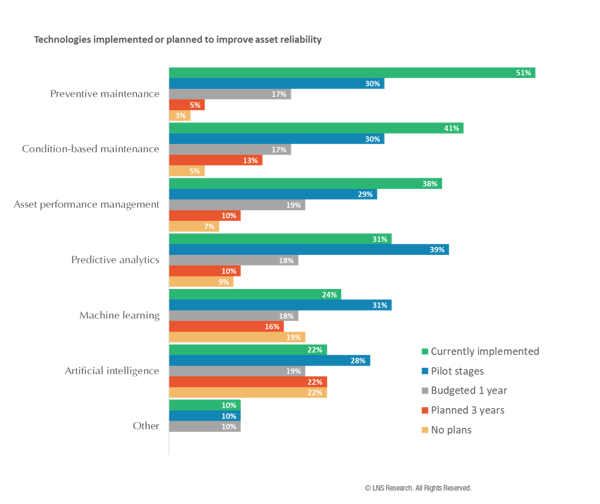On Wednesday, March 13, LNS Research hosted the webcast “Digital Readiness for Industrial Transformation: Success Lessons from Real-World Leaders.” The presentation covered the scope, scale, strategy, budget, and organization of Industrial Transformation (IX) programs globally. The session also investigated the technology choices made in the IX programs, and how these new technology choices balance against Operational Technology (OT) and Information Technology (IT).
1. Are there notable differences across regions, industries, or company size among those succeeding with IX?
The area where there were the most significant differences is around company size.

IX Leaders were atypically distributed by revenue: over 33% of Leaders have revenues of $1-$5 Billion despite being only 16% of respondents. These companies are big enough to have a meaningful IX program but small enough that differences in geographies and business units/types don’t overwhelm the program.

In terms of Industry type, infrastructure (utilities, transportation, etc.) companies had the highest percentage of IX Leaders. The impact of smart meters in electrical utility grids and advanced industrial analytics in wind farm production are two examples of IX programs having “dramatic results.” Batch manufacturers (pharmaceuticals, specialty chem, etc.) have made the least progress with the highest percentage of companies still in the early stages of IX. We will be watching them closely over time to see their progress.

In terms of geography, we were surprised to see the level of engagement across all major geographies. However, the results indicate that more European companies see themselves as “stuck in the pilot phase” when compared to companies in other geographies.
2. My company hasn’t started an Industrial Transformation program yet. What can we do in the meantime to position the company for success when it does finally get started?
If your company is one of the those that have “no plans” to initiate an IX Program or even one that has plans three years out, LNS recommends a Three-Step Program:
- Leverage your challenges into transformational opportunities: The primary reason companies are not initiating IX is because they are already consumed in a major IT roll-out or upgrade. Data shows that the companies with “no plans” are behind in OT and IT. Therefore, focusing on upgrading and standardizing those systems is the core transformational opportunity for these companies.
- Focus on business changes and not just technology changes: IX Leaders are 31% more likely to focus on business process change. Go look for opportunities, maybe around something like compression of processes that cross organizational silos and work to define the “To Be” vision. Such impactful work can be done without an organizational consensus on the need for an overarching IX Program and without a major technology investment initially. This can get the ball rolling.
- Build organizational consensus slowly: Play the “long game.” Share success stories. Get more people on LNS webinars and, dare I say it, our competitors’ webinars. Champion the flow of information without the expectation of some immediate change in organizational behavior. Focus on plant management and executives because top down and bottom up approaches are required.
3. Is there any specific technology that’s taking off and delivering results?
Many applications and technologies that are doing well in specific industries and niches. Smart metering in electrical distribution is delivering value. Fleet management and remote operations centers appear to offer real value in mining. We at LNS would not be surprised to see the market carved up by industry with specific technology and vendors more successful in particular industries over time.
Overall though, we do not have enough data, yet, to answer the question across the wide variety of technologies and industrial organizations engaged with IX. What we do know so far is that IX Leaders are engaging in 2.5 times the number of technologies, and that includes not just IIoT but several other technologies like robots and cobots. Additionally, the choice for plant management is critical to the success of IX given the funding model. We will monitor the market closely for any trends across industries.
4. It seems like connected assets is a common use case. What are companies doing around this?
There's a growing maturation of technologies associated with asset reliability and maintenance over time.
 Companies are progressing up the maturity curve with increasing penetration from preventative to condition-based all the way out to the newest technologies of machine learning and artificial intelligence. In line with what we saw for IX overall, companies are actively piloting a larger number of different asset-focused technologies. These newer technologies are getting the attention their potential deserves.
Companies are progressing up the maturity curve with increasing penetration from preventative to condition-based all the way out to the newest technologies of machine learning and artificial intelligence. In line with what we saw for IX overall, companies are actively piloting a larger number of different asset-focused technologies. These newer technologies are getting the attention their potential deserves.
5. What is the most common mistake companies make with the IX program?
If I look at all the best practices holistically, it is clear to me that if you are going to initiate a successful IX program, you need to be “All In.” Transformation is hard, and everybody already has a day job. Don’t just play with technology (even if experimentation is essential).
LNS has a research spotlight going live in a couple of weeks on the organizational “disconnects” we found around IX (some of which we detailed in the webinar). The findings indicate that many companies start their IX Program, for whatever reason, seemingly without a real commitment to it and definitely without the organizational consensus needed to drive the transformational change. Research indicates they are starting a program doomed to stagnation or outright failure.
Don’t start until you are ready and once you do engage and commit.